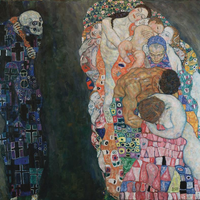More about Charles Sheeler
- All
- Info
- Shop
Works by Charles Sheeler

Sr. Contributor
Charles Sheeler wanted nothing to do with the American pastoral scenes of rolling hills and bales of hay.
For Sheeler, gone were the days of Grant Wood, Grandma Moses, and their idyllic, country landscapes. The United States was industrializing, and Sheeler was eager to capture its new spirit of modernity. Did any famous artist get anywhere by just following along with the trends? Rules – especially art rules – are meant to be broken in the quest for greatness.
Sheeler’s thirst to change the future of art began when he encountered European modernists like Marcel Duchamp at the Armory Show in New York in 1913. This landmark exhibition was America’s first introduction to the wild styles of the European avant-garde, and it was a shock to the prevailingly prude American art sensibility. Sheeler was one of the few American artists who showed work at the exhibition, but the real impact was seeing how much farther ahead European artists were than those in the States. While Duchamp was wrestling with the concept of art itself, Sheeler was mingling with artists like William Merritt Chase, who still thought that Impressionism was on the cutting edge of art...in the twentieth century! You can only imagine his shock when he saw what was really going down.
Around this time, Sheeler also picked up photography, which was still a fairly new medium. Sheeler taught himself how to take pictures on a cheap Kodak camera. He was smitten with this new technology and quickly understood how photography could help shape his approach to creating art. He even had a sweet job photographing the collection of The Metropolitan Museum of Art.
Sheeler’s exposure to European modern art, coupled with his love for photography, prompted him to get pretty weird with the act of painting itself. He blended the two art forms in such a unique way that he often referred to painting and photography as his separate eyes, which both helped him perceive the world. Sheeler’s art developed in tandem with the work of Charles Demuth, and the two were known as the heavy hitters of a new style called Precisionism.
Sources
- Arnason, H.H., and Elizabeth C. Mansfield. History of Modern Art. Upper Saddle River, NJ: Pearson Education, Inc., 2013.
- Murphy, Jessica. “Charles Sheeler (1883–1965).” Department of Modern and Contemporary Art. The Metropolitan Museum of Art. November 2009. https://www.metmuseum.org/toah/hd/shee/hd_shee.htm. Accessed October 30, 2018.
- National Gallery of Art. “Charles Sheeler, Across Media.” Slideshows. https://www.nga.gov/features/slideshows/charles-sheeler.html#slide_1. Accessed October 30, 2018.
- New-York Historical Society. “About.” The Armory Show at 100. http://armory.nyhistory.org/about/. Accessed October 30, 2018.
- The Art Story. “Biography.” Charles Sheeler. Artists. https://www.theartstory.org/artist-sheeler-charles-life-and-legacy.htm. Accessed October 30, 2018.
Featured Content
Here is what Wikipedia says about Charles Sheeler
Charles Sheeler (July 16, 1883 – May 7, 1965) was an American artist known for his Precisionist paintings, commercial photography, and the 1921 avant-garde film, Manhatta, which he made in collaboration with Paul Strand. Sheeler is recognized as one of the early adopters of modernism in American art.
Check out the full Wikipedia article about Charles Sheeler

















